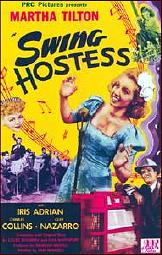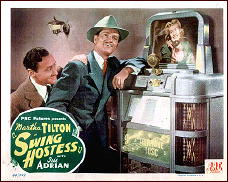Sat 29 Sep 2012
Movie Review: SWING HOSTESS (1944).
Posted by Steve under Films: Comedy/Musicals , Reviews[14] Comments

SWING HOSTESS. PRC, 1944. Martha Tilton, Iris Adrian, Charles Collins, Cliff Nazarro, Harry Holman, Betty Brodel, Philip Van Zandt, Earle Bruce. Music and lyrics by Jay Livingston, Ray Evans and Lewis Bellin. Director: Sam Newfield.
There are maybe three reasons to watch this low-budget wartime musical, and the first, by a wide margin, is Martha Tilton, perhaps best known as a longtime singer for the Benny Goodman band. In Swing Hostess she plays an aspiring singer named Judy Alvin who can’t seem to catch a break in show business, what with a series of never-ending mixups between who sang what song on which recording disk, missed phone calls and messages, and a competitor (Betty Brodel, sister of Joan Leslie) who can’t sing but whom fortune seems to smile upon a lot more often.
Miss Tilton made only a handful of movies, and was one of the stars in even fewer, but she has a pleasant and relaxed onscreen presence that should have opened the door for making many more. She sings six songs in Swing Hostess, all charmingly and in good cheer. Back in the 1940s you’d have gotten your money’s worth from this film from the music alone. (If you’re of a certain age, today as well, for that matter.)

Another interesting aspect of Swing Hostess is that a sizable portion of it takes place at Judy Alvin’s day job, as she waits for bandleader Benny Jackson (Charles Collins) to notice her. Instead of self-contained juke boxes, back in 1944 they apparently consisted of units with phone lines to a central location where the operators would locate the 78 on a rack and play it back to the person on the other end whose nickel or dime it was. I’ve not been able to find anything online about this kind of operation, if it really existed, so if anyone knows more, tell me about it.
The plot is really rather dopey and not worth saying anything more about, but some of the supporting cast is worth a mention. I’ve probably heard comedian Cliff Nazarro’s double talk ability before, but if so, I’d forgotten about it. All I can say is amazing. Earle Bruce, whose nice guy character seemed to be on a direct path to Judy’s heart, is dumped in the middle of the movie and sent off to the army instead. This gives bandleader Benny Jackson a clear shot, which he takes full advantage of, but since this was the only movie that Bruce ever made, even at this late date I’m going to cry foul.
September 29th, 2012 at 6:05 pm
Steve,
In My Dream Is Yours, some years later, Doris Day played one of these people who found a record for you. An almost really good ppicture, Eve Arden, S. Z. Sakall, Adolphe Menjou and best of all Jack Carson, give this a soul. If it’s used as a device more than once, years apart at different studios, there must have been something.
September 29th, 2012 at 10:23 pm
Steve,
Apparently several jukebox companies — Wurlitzer, Seeburg, and especially Rock-Ola — had Telephone Jukeboxes in the Forties that worked a la Swing Hostess. According to a jukebox history website (the Internet never ceases to amaze), the last Crime Doctor movie, Crime Doctor’s Diary, also includes a scene that shows one of these systems.
September 29th, 2012 at 11:03 pm
Barry and Jim
Great info. Thanks! I didn’t think it would take long for someone to help me out. I looked only under jukebox on Wikipedia and didn’t get very far, even following up there under Rockola.
But Googling just now for both “telephone” and “jukebox,” I must have found the same web page you did, Jim:
http://www.automatlunch.com/2010/04/telephone-jukebox.html
There are scenes from all three movies. Very nice!
September 29th, 2012 at 11:22 pm
Steve,
That is a terrific piece and a fascinating if minute part of our culture.
September 29th, 2012 at 11:28 pm
Just to round out the discussion, there’s also the matter of the really odd video jukebox in the Sidney Toler/Monogram Charlie Chan film, The Shanghai Cobra. When you put in your money, you actually saw the young woman who took your request put the record on. It’s hard to believe that there was ever such a device, but then I didn’t know about the telephone jukebox either!
October 1st, 2012 at 8:48 am
There’s also a movie called “The Blonde from Brooklyn” (1945) that features that sort of “centralized jukebox” thing.
October 1st, 2012 at 10:19 am
Everybody else seems to have covered the basic question about the telephone jukeboxes pretty well.
But someone mentioned The Crime Doctor's Diary …
It’s more than just “a scene that shows the system”.
The whole movie is plotted around two rival companies in the business.
What I remember mainly is that one of the companies employed a dimwitted guy who fancied himself a singer-songwriter, who put his own song in the system and then went around to joints and called in to get it played. This song turned out to be a major clue to help Warner Baxter solve the case.
The dimwitted guy was played by Whit Bissell, against type and actually kind of endearing.
As to the song …
… it’s an ode to the French horn Bissell played as a kid; it may well be the worst song ever in a movie, and Bissell’s vocal has to be heard to be believed:
“In the house where I was born
There’s a little brass French horn
That I used to toot
When I was just a boy
Toot-toot-de-toot-de-toot!”
I’ve never forgotten this song …
… and believe me, I’ve tried.
October 1st, 2012 at 12:20 pm
There’s also a story in the Dick Tracy newspaper comic strip in the 1940s about such a jukebox set up. I don’t have time right now to look it up and give you the dates.
October 1st, 2012 at 12:35 pm
Mike Tooney Says:
October 1st, 2012 at 12:34 pm
Steve – You mentioned Cliff Nazarro and his doubletalking abilities.
They’re both highlighted in DIVE BOMBER (1941), with Cliff as a hospital corpsman in a comic relief subplot that was pretty much required in most Hollywood features of the era:
http://www.imdb.com/title/tt0033537/
Except for those marvelous aerial shots of pre-World War II Navy aircraft and Cliff’s shenanigans, there really isn’t much to recommend about DIVE BOMBER, a vivid Technicolor recruiting poster hamstrung with cliches galore.
October 1st, 2012 at 1:45 pm
I find this extremely interesting. If it weren’t for all these movie references to them, I don’t think anyone would know that telephone jukeboxes ever existed, how they operated or anything.
Randy’s found a story involving one in a comic strip, and I’ve just found one on radio, an episode on NIGHTBEAT starring Frank Lovejoy, with major parts by William Conrad and Jeff Corey. It’s called “Jukebox Julie,” and involved a romance of sorts between a dwarf and his dream girl, whom he talks to ten seconds at a time through the jukebox:
https://www.youtube.com/watch?v=jwldSCkAv6A
The show’s from 1951, so they were still around then, probably in big cities only, but familiar enough to the rest of the country that the setup didn’t need a lot of explanation.
October 1st, 2012 at 2:04 pm
A good example of a Cliff Nazarro comedy routine can be found on YouTube:
https://www.youtube.com/watch?v=YI80XILk37w
It’s taken from a radio show called COMMAND PERFORMANCE, so there’s no real video. His portion of the program starts at the 4:50 mark.
Quite coincidentally he follows Martha Tilton singing “The Trolley Song.”
October 1st, 2012 at 2:07 pm
Mike Doran, Comment #7:
I have a feeling that you’re going to be hearing that song all day long!
October 2nd, 2012 at 8:09 am
Trivially, I suspect from the early 1960s onward, a rather different sort of film might be expected with a title such as SWING HOSTESS…one does wonder what kind of gimmicky jukeboxes, in the pre-Scopitone days, had some sort of visual component keyed to individual recordings…
February 11th, 2021 at 10:37 pm
[…] Centralized telephone jukebox systems have come up for discussion on this blog before, that so happening as part of my review of Swing Hostess (1944), starring Martha Tilton, and the comments following. Here’s the link: Click here. […]